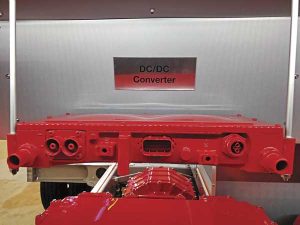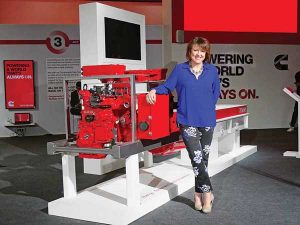The next generation battery electric system from Cummins Inc. is adding to the ease of CV electrification.
Story by Ashish Bhatia
 Unveiling its next generation Battery Electric System (BES) at Busworld Europa 2019, Cummins Inc. has one again drawn attention to the work it is doing in the area of easily accessible, zero-emission powertrain designs for CVs. Eyeing a significant play in some of the most competitive markets in the world like Europe, the tier automotive supplier is looking at BES, which includes a low-profile battery, to play a key role in furthering its electrification strategy. Aiming the technology at buses, the low floor ones especially, Cummins with the BES technology is keen to highlight its prowess to mix and match existing as well as new solutions in the electric CV space. What makes BES technology highly relevant in this context is its capability to find use in various types of CVs. Claim sources close to the company, that the new, low-profile battery of the BES technology uses the latest in cell technology.They inform that the respective technology in low floor requirements is engineered to facilitate a low centre of gravity. It is also engineered to maximise the utilisation of unoccupied space, they add.
Unveiling its next generation Battery Electric System (BES) at Busworld Europa 2019, Cummins Inc. has one again drawn attention to the work it is doing in the area of easily accessible, zero-emission powertrain designs for CVs. Eyeing a significant play in some of the most competitive markets in the world like Europe, the tier automotive supplier is looking at BES, which includes a low-profile battery, to play a key role in furthering its electrification strategy. Aiming the technology at buses, the low floor ones especially, Cummins with the BES technology is keen to highlight its prowess to mix and match existing as well as new solutions in the electric CV space. What makes BES technology highly relevant in this context is its capability to find use in various types of CVs. Claim sources close to the company, that the new, low-profile battery of the BES technology uses the latest in cell technology.They inform that the respective technology in low floor requirements is engineered to facilitate a low centre of gravity. It is also engineered to maximise the utilisation of unoccupied space, they add.

To be offered as part of a broader modular platform, the BES technology is made uniue by its ability to offer high energy density and packaging efficiency. Offering an exciting glimpse of Cummins’ future product plan for electrified powertrains, according to Julie Furber, Vice President of Electrified Power at Cummins, the BES technology is engineered to support the rise in speed of electrification of buses. Buses in the public transport sector especially. Of the firm opinion that batteries with faster charging and a longer range will mark a breakthrough, Furber averred that Cummins is working in that direction. Well aware that such a development will mark a distinct technological shift, and especially in view of the regulatory requirements, she mentioned that easy adoption (and accessibility) will be at the top of the preference list. Pointing at the low profile battery, which measures under 140 mm in height in a 8.9 m long bus as part of the BES technology, she explained, that a development like this amounts to a significant development indeed. Displayed alongside the high energy BP74E batteries mounted in the roof and the Cummins System Controller at Busworld Europa, the BES technology could be well integrated with a number of technologies, including the e-Drive.

The e-Drive is a single unit of traction system, which combines a motor, transmission and an inverter. It is lightweight in construction. Together with the BP393 battery, which marks the latest in battery technology that Cummins has to offer, the e-Drive system is already on its way to become a crucial part of the tier automotive supplier’s future product roadmap. It is, according to Furber, coupled with the global support offered by the Cummins network, and combines the reliability customers expect of Cummins with the efficiency of next-generation electric drivetrains in a form factor designed for easy adoption. What makes it interesting perhaps, is how the BES technology could effectively drive down CO2 emissions. As per a company statistic, a Cummins powered electric bus can reduce CO2 emissions over a one-kilometre range by 600 gms in comparison to a Cummins B4.5 diesel engine powered bus. Interestingly, the whitepaper – ‘Future of Fleets’, by Cummins stresses upon spurring collaboration and market growth for electrified powertrains in CVs. It hints at the importance of BES technology and how it could entice OEMs. The white paper also makes an interesting reference material for decision makers by identifying technological, infrastructural, economic and regulatory factors.
 Future of Fleets
Future of Fleets
Projecting the whitepaper as the latest piece of work that aims to serve those who are starting out or continuing on the path of CV electrification, Cummins, claim sources, seeked inputs of leading companies in the field while preparing it. Stating that it is vital to diversify a country’s traffic to low emission vehicles, the whitepaper points at how Cummins has made the provision to drive its electric vehicle strategy. The tier supplier has, in fact, earmarked USD 500 million for the purpose. In the realm of research and development to be precise, Cummins Inc. is continuing to work on optimising the battery design. It is looking at the use of innovative materials for anode and cathode manufacture. Stating that such a move will positively impact the battery’s capacity as well as the cost per kilowatt-hour, Furber mentioned, that the use of innovative materials for anode and cathode manufacture has the potential to maximize the battery life, optimise the charging rates, manage the temperature range and ensure utmost safety.
Expecting ‘vehicle-to-grid’ technology to be highly beneficial, Cummins has identified an opportunity to defray the costs of electrification. Of the opinion that arrangements like feeding of stored power from a school bus back to the grid will benefit the power network at large, the company is keen that the collaboration between CV operators, utilities, legislators and technology vendors should rise to the next level. Confident that the feeding of stored power from a school bus back to the grid will benefit the power network at large through load balancing against the changing demand patterns, Cummins is studying the financial benefits in doing so. It is gauging if such a move will lower the total cost of ownership of EVs. Of the opinion that such a proposition will be beneficial for EV owners as well as the other stakeholders involved, Cummins is looking at a significant shift in the school bus space in coming years. It is thus toying with the idea of utility companies in the state purchasing electric school buses and leasing them to schools with the potential to lower the upfront financial barrier to entry. Studying ways to dial sustainability and grid stability, Cummins Inc., has through its whitepaper asked for the attention of the industry to the Osborne effect, and how it should not be ignored.
Planet 2050 Strategy
Announcing environment sustainability goals to 2030 and aspirations up to 2050 in a bid to do its part in addressing climate change, Cummins Inc. is banking on BES technology to electrify public transport buses such that they are sustainable and of superior value. It has outlined science-based goals for products and facilities up to 2030. These are aligned to the United Nation’s Intergovernmental Panel on Climate Change (IPCC). Looking at a considerable shift towards carbon neutral technologies that address air quality, Cummins is confident that growth in the future will come from addressing the concerns pertaining to climate change, and by contributing to the cause of limiting the global temperature rise to no more than 1.5 degree Celsius. Continuing to work on the targets including reduction of energy and water use as well as CO2 emission from the products, the tier supplier has outlined how its new strategy builds on the success of goals announced by the company in 2014 and timed to 2020.
Working on targets that include reduction of energy, water and CO2 emissions, Cummins Inc. has set eight 2030 goals that pertain to parts, products and company managed facilities as well as operations. Further classified into two categories, they are about addressing climate change and air emissions, and about using natural resources in the most sustainable manner. To evaluate the progress made on the 2030 goals in a bid to decide on the shortcomings if any on the global energy and environmental challenges, Cummins is confident that its solutions for electrification of CVs will find more and more takers. Said Brian Mormino, Executive Director Worldwide Environmental Strategy and Compliance, Cummins Inc., that it is really important to work with carbon-neutral products and operations. Our communities and businesses depend on a healthier planet, and it is therefore necessary to take strong action on climate change and work towards a future where nothing is wasted, he added.

























